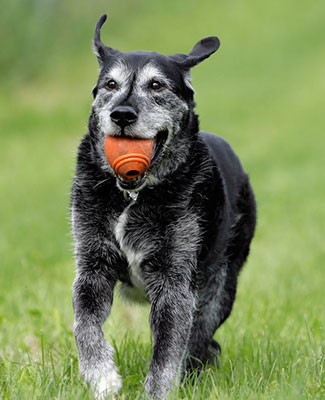 We know that when it comes to people there is no ‘one size fits all’ programming. What works for me in terms of a fitness regimen won’t necessarily work for you or vice versa. The same holds true when it comes to a fitness program for your dog. As fitness professionals, we must take into consideration each unique canine situation and stage in life and tailor the program to fit those needs.
We know that when it comes to people there is no ‘one size fits all’ programming. What works for me in terms of a fitness regimen won’t necessarily work for you or vice versa. The same holds true when it comes to a fitness program for your dog. As fitness professionals, we must take into consideration each unique canine situation and stage in life and tailor the program to fit those needs.
The populations that we work with can be broken down into five categories.
- Puppy
- Pet
- Performance or Working
- Special Conditions
- Senior
We must work within certain parameters to meet the needs of the individual in each of these categories. What works for your star fly ball athlete will not work for your obese housedog. While we make sure the fundamentals are in place for everyone, where we go from there takes some creative chops and an understanding of the needs of the individual we are training. We will look at each category and how it uniquely fits into the canine fitness-training model.
 The first population we will look at are puppies. At this stage of development puppies are like a little sponges, soaking up all the information around them. Our goals as pet owners and trainers at this stage are to build confidence, positive associations, and influence neural pathways to help the puppy move and recognize where their bodies are in space. Until the puppy’s growth plates close (verified through x-ray) or by following the 24-month rule, exercise regimens should be kept short and simple. A great way to start off the training regimen at this stage is to grab about 20 small treats and have at it. Introduce them to a variety of surfaces and equipment and let them explore. Begin teaching them basic cues such as sit, down, and touch. Short and sweet is the name of the game. Keep sessions 5 to 10 minutes long while avoiding any long endurance type activities or those that involve repetitive impact. We want them to have a love of the game and gain the necessary basic skills in order to advance to the next level.
The first population we will look at are puppies. At this stage of development puppies are like a little sponges, soaking up all the information around them. Our goals as pet owners and trainers at this stage are to build confidence, positive associations, and influence neural pathways to help the puppy move and recognize where their bodies are in space. Until the puppy’s growth plates close (verified through x-ray) or by following the 24-month rule, exercise regimens should be kept short and simple. A great way to start off the training regimen at this stage is to grab about 20 small treats and have at it. Introduce them to a variety of surfaces and equipment and let them explore. Begin teaching them basic cues such as sit, down, and touch. Short and sweet is the name of the game. Keep sessions 5 to 10 minutes long while avoiding any long endurance type activities or those that involve repetitive impact. We want them to have a love of the game and gain the necessary basic skills in order to advance to the next level.
 Next is our pet population. Adopting a healthy life style will set these dogs up for long term success and cultivate the human animal bond while simultaneously decreasing their chances for disease. Research has shown that as little as 30 minutes a day of exercise in humans can prevent the occurrence of certain diseases. The same holds true for our pet populations. In this stage the goals the owner has for their pet should be discussed along with all the benefits of a healthy lifestyle. In this stage we are not trying to build super athletes, unless of course that is a goal the owner has, rather we are ultimately trying to promote a healthy lifestyle that will last through all the stages. After assessing the dog’s level of fitness we can build a custom plan to meet the needs of the whole family.
Next is our pet population. Adopting a healthy life style will set these dogs up for long term success and cultivate the human animal bond while simultaneously decreasing their chances for disease. Research has shown that as little as 30 minutes a day of exercise in humans can prevent the occurrence of certain diseases. The same holds true for our pet populations. In this stage the goals the owner has for their pet should be discussed along with all the benefits of a healthy lifestyle. In this stage we are not trying to build super athletes, unless of course that is a goal the owner has, rather we are ultimately trying to promote a healthy lifestyle that will last through all the stages. After assessing the dog’s level of fitness we can build a custom plan to meet the needs of the whole family.
For our next population, the working or performance dog, education and injury prevention are key. Performing a complete assessment and tailoring the training to the dogs current abilities will ensure they can stay longer in the field and lessen their chances of injuries. Getting to know the unique skill set that each of these dogs needs for their sport or job will also help you individualize their programming. It also helps to identify the owner’s goals or competitions for the month and possibly the year. This way you can tailor workout loads according to a periodization model and know when to ramp up or ramp down the programming. These types of dogs will most often be able to work at higher intensities and longer duration than those in the normal pet population. Making sure all the foundation movements are strong and revisiting them as necessary will keep the athlete in tiptop shape.
For dogs that fall into the special conditions category, attention should be paid to what restrictions and limitation they have and what the goals for recovery or maintenance are. Whether it’s a disease process or recovery from an injury, connecting with the entire health care team will go a long way to designing the best possible program for this client. In addition, taking a full detailed history and knowing what a typical day in the life of this client looks like will help in tailoring a specific workout regimen.
 Last but not least, we have our senior population. For this population, exercise can mean so many things. It can help alleviate arthritic pain, it can improve cognitive function, it can help slow a disease process, and it can improve overall quality of life. Typically in this population, work out time and intensity will be lessened and extra warm ups will need to be put into place. Again, a team approach should be taken into consideration with a senior pet that may be on medication or have a condition that may affect their programming. Adding an exercise program to a senior pets life can increase the human animal bond further and add a dimension that can bring a renewed sense of vitality.
Last but not least, we have our senior population. For this population, exercise can mean so many things. It can help alleviate arthritic pain, it can improve cognitive function, it can help slow a disease process, and it can improve overall quality of life. Typically in this population, work out time and intensity will be lessened and extra warm ups will need to be put into place. Again, a team approach should be taken into consideration with a senior pet that may be on medication or have a condition that may affect their programming. Adding an exercise program to a senior pets life can increase the human animal bond further and add a dimension that can bring a renewed sense of vitality.
As a fitness professional we will come in contact with many different populations, all with their own unique needs and challenges. Embrace their uniqueness and strengths to get the most out of each workout.

About the Author: Genevieve Cahill, founder of Modern Animal Behavior has been a Certified Veterinary Technician for 15 years. All throughout her life she has been very passionate about two subjects, fitness and behavior. She completed her two undergraduate degrees in Psychology and Communication and is now pursuing her Masters Degree in Companion Animal Behavior Counseling. Recently, Genevieve found a way to merge her two passions via the FitPAWS Master Trainer/ University of Tennessee Canine Fitness Trainer program and her masters thesis work researching how exercise enhances learning/behavior in shelter dogs. Genevieve believes that behavior and exercise can be completely intertwined and is passionate about bringing that message to pets and their owners. Genevieve’s background as a Certified Personal Trainer through the National Academy of Sports Medicine (NASM) and her many years as a Veterinary Technician have prepared her to jump right into this up and coming world of canine fitness.
